Living Off The Grid
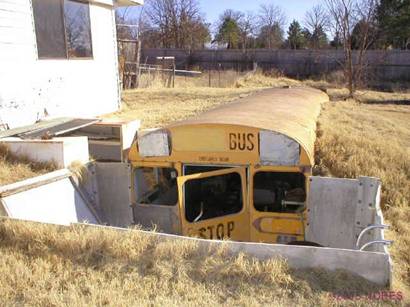
 |  | |
| Root Cellaring: Natural Cold Storage of Fru... by Mike Bubel $10.17 | Putting Food By (Plume) by Janet Greene $11.56 |

 |  | |
| Root Cellaring: Natural Cold Storage of Fru... by Mike Bubel $10.17 | Putting Food By (Plume) by Janet Greene $11.56 |
 CATEGORY B - SHELTER, BUILDINGS
CATEGORY B - SHELTER, BUILDINGSIntroduction to the
Sport of Dog Scootering
![]()
By Daphne Lewis
Author of My Dog Likes to Run. I Like to Ride...
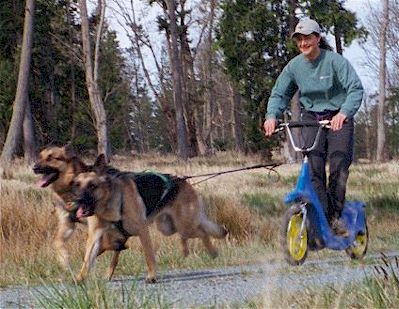
Sue Meinzinger with Parker and Zeus
Parker and Zeus, Sue Meinzinger's two German Shepherds, www.pack-leader.com, know how to pull a Sacco cart very fast. They race fall and winter with the Northwest Sled Dog Association. When Sue hitched her shepherds to my Jones Dog Scooter one Sunday afternoon in April, these experienced dogs knew what to do. They took off at a lope down the trail pulling Sue on the scooter easily and fast.
If your dogs, like Sue's, know what to do with sleds and carts, it is easy to switch to a scooter. A scooter opens up new possibilities. In Sue's case she now can follow narrow paths through the woods where the Sacco cart could not go. She can exercise along with the dogs by scooting to keep up speed. She can put the scooter in the back of the car along with the dog and be more spur of the moment with her outings.
My Rottweiler, Rubromarginata, has different skills from the shepherds. He is not fast. He is easy going and predictable. Because of his calm attitude, I love to explore the city by dog scooter. One afternoon in early May, I decided to take a little city run to celebrate the end of Rubro's convalescence from his car accident in December. We parked on a street end near the Burke Gilman Bicycle trail. I hitched Rubro to the scooter. (Skill: dog picks up feet on command and helps put on harness.)
The bicycle trail is out of sight beyond the shrubs and trees. Rubro found the tiny path connecting the street end to the trail without my guidance so we scooted onto it with no voice commands. (Skill: dog looks for the likely route and uses judgment to find it.) At the end of the path we turned left (hawed) onto the paved trail. (Skill: Dog knows the command, "Haw".)
We went along about half a mile (Skill: dog trots steadily and stays to the right of the trail so faster trail users can pass to his left.) and then turned right (gee'd) and started downhill onto a sidewalk. I used the brakes going down the hill and Rubro trotted ahead of me. We waited at the traffic light. (Skill: dog waits at a stand stay when told to "Wait". Does not spook at traffic.) The light turned to "Walk" and Rubro trotted across the street to the entrance into Magnuson park. (Dog travels in straight line across intersections going from sidewalk to sidewalk.)
There was no sidewalk so we scooted along the road hugging the shoulder. Bicyclists passed us and so did cars pulling trailers to the boat launch. We scooted across the parking lots, squeezed through some log road barriers and hawed onto a paved trail that parallels Lake Washington. When we came to the Porta Potty, I laid the scooter on its side where Rubro would be in the shade. Ruby waited for me while I was inside. (Dog waits when scooter is laid on its side.)
It was a beautiful Sunday afternoon. We passed children learning to ride two wheel bikes and older siblings practicing their roller blades and skateboards. (Dog knows the command "Pass Haw" which means veer to the left to pass on the left side of the people in front of us.) Rubro was panting but did not seem too hot. I told him we were going to the Dog Park and soon he could swim. We passed the hill where people fly kites and then the sculptures of orca fins rising from the turf. Finally we arrived at the gate to the dog park. I opened the gate and to the water we scooted. I took off Rubro's harness and took the dummy from my bag. I threw it far into the water. Many retrieves later Rubro is back in harness and we are ready to circle back to the car through the furthest gate of the Dog Park.
As we proceed on the cindered trail, Rubro passes many dogs walking and playing and catching Frisbees off leash. (Skill: Dog knows that when he is in harness he does not stop to play. He keeps on going in a straight line.) Most of the dogs ignore him. Several times a dog comes to investigate and gets between Rubro and the scooter. This causes no problem because Rubro ignores their advances and just keeps trotting and I steer the scooter around the dogs. No dog wants to pick a fight; they are just curious or want to play. Rubro always keeps on the right side of the trail.
After we leave the dog park, I tell Rubro "Go to the car". We take short cut across a 200 yard rough field. I like to scooter off pavement when I can. (Skill: Dog will strike a straight line across an open space even when there is no trail.) Once back on the entrance road to the Park, we retrace our steps to the traffic light, up the hill and back onto the bicycle trail. Half a mile down the Burke Gilman Trail, Rubro finds the little path that threads back to the street end where we had parked. (Skill: retracing steps/going back to the car/saving owner from being lost.) In the car Rubro is not panting at all. He is not overheated. The end of a long convalescence from a dislocated right elbow is in sight.
My Rottweiler, Rubromarginata, and Sue Meinzinger's German Shepherds, Parker and Zeus, have different skills. I had the opportunity to scooter with Sue's super athletic Zeus. When I rode a scooter with Zeus pulling, he ran to catch Sue. Zeus ran so fast my baseball cap blew off my head! Sue's dogs are fast, strong, and athletic. Rubro is reliable, easy going, and friendly with both dogs and people. The ideal scooter dog would have Zeus' speed and Rubro's biddability and relaxed attitude toward strange dogs and people.
How do you train a dog to pull a scooter? There are many ways.
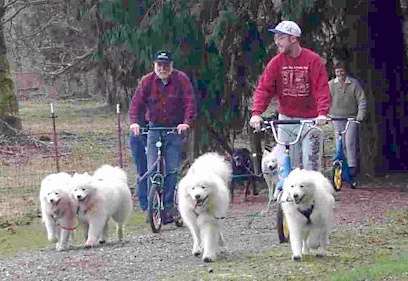
Steve & Jason Loper and friends
with author, Daphne Lewis, and Rubro
QUICK METHOD
I heard of this method from Andrew Pinner in Australia. He harnessed his German Shepherd to his scooter and had his wife ride her bike in front of him. The shepherd chased after the wife. In two outings the shepherd knew how to pull a scooter.
ALSO QUICK
I used to walk Rubro around an urban lake called Green Lake. It took an hour and it was how I got my exercise. Rubro was very familiar with this no-brainer trail. One day I put on roller blades and a harness on Rubro. He was scared to go in front of me because he was trained to walk quietly beside me. I kept waiving him on and whenever he went in front instead of beside me, I told him, "Good dog".
Soon Rubro ran in front of me. A few more outings around the Lake and Rubro knew how to run in front of me and pull. He learned that when the leash is on the harness he is to pull and when the leash is on the collar he is to walk by my side without pulling.
An unforeseen advantage of training at Green Lake was that due to heavy pedestrian use, wheeled traffic can only go counter clockwise around the lake and can only stay on the right side of the trail. Rubro learned to stay to the right on sidewalks and trails.
ALSO QUICK
A friend hitched her two dogs to one of my scooters on a Saturday afternoon. They followed Rubro and me and our scooter down a path in a wooded park. When the two dogs stopped to smell the bushes, my friend said "No. On by!." By the end of the short trip they were getting the idea that you run in harness. You smell the bushes when on a casual walk with leash on collar.
TRADITIONAL
Mushers train by allowing the pups to run along freely beside the adult dogs when they are pulling carts on training runs. When the pups are old enough, they are put in harness with a small team and taken on very short runs, say half a mile. The mushers make sure that the runs are fun for the pups. The runs are not too fast and not too long. The pup should be wanting more when the run is over.
SLOW AND CAREFUL
My book, "My Dog Likes to Run. I Like to Ride", other training books and magazines such as "Mushing" describe how to train a dog in greater detail than I can here.
Practice mushing commands whenever you are walking on a leash. If you are about to turn right. Announce it. "Fido! Gee!" then pivot right. Are you coming to a traffic light? Say, "Wait" and stop. Put the harness on the dog. Attach a log or 2 x 4 or small tire. Go for walks with the dog pulling the "drag". Lots of "good dog!" For initial runs go to a safe familiar trail with no auto traffic.
Dogs naturally want to go! Having worked recently with novice dogs, I think the most important new command would be "Stand". "Stand" means "stay in place; don't turn in circles and tangle the lines and harness!" "Stay" will do the same job if the dog understands that "Stay" means don't move your feet. Rubro knows that when he is in harness and comes to a stop he stands. He never turns and tangles the harness. I do not need to use the command "Stand" except as a reminder at dangerous intersections when we are, say, waiting for a traffic light to change.
Have fun. As the weeks go on, consider the skills listed in the little story above. Each skill takes time to teach. The challenge of teaching the next skill is why this sport is rarely boring. For me and Rubro the next skill will be adding a third speed. Rubro knows "walk" and "trot". "Hurry" gets a slightly faster trot for about 50 feet. He has loped only three times in four years while pulling the scooter. The command for loping or running is "Hike!" I have two ideas of how to teach this... Ahh the challenge of training dogs...
P.S. Today Rubro and I went on a trail beside the Cedar River in Renton, Washington. Squirrels ran in front of us. Rubro speeded to a lope and remained on the path even though the squirrel did not. So he has loped four times not three. There is hope for speed on command.
/Daphne Lewis
For more information about dog scootering, visit
www.dogscooter.com
 Permaculture is a design system based on ethics and principles which can be used to establish, design, manage and improve all efforts made by individuals, households and communities towards a sustainable future.
Permaculture is a design system based on ethics and principles which can be used to establish, design, manage and improve all efforts made by individuals, households and communities towards a sustainable future.


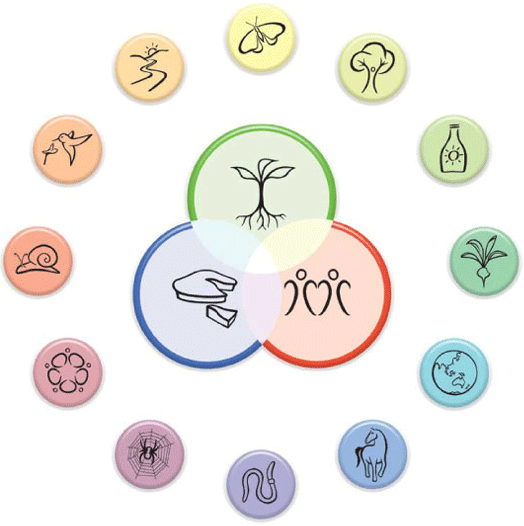

 The term “nature-deficit disorder” was coined by author Richard Louv in his book “Last Child in the Woods” to describe what happens to young people who become disconnected from their natural world. Louv links this lack of nature to some of the most disturbing childhood trends, such as the rises in obesity, attention disorders, and depression.
The term “nature-deficit disorder” was coined by author Richard Louv in his book “Last Child in the Woods” to describe what happens to young people who become disconnected from their natural world. Louv links this lack of nature to some of the most disturbing childhood trends, such as the rises in obesity, attention disorders, and depression.
Research is also showing that getting young people outdoors is helping ease attention disorders.
 | Click the image to access the original scientific article "Coping with ADD" Faber Taylor, A., Kuo, F.E., & Sullivan, W.C. (2001). “Coping with ADD: The surprising connection to green play settings.” Environment and Behavior, 33(1), 54-77. Questions? Contact Frances E. Kuo (fekuo@uiuc.edu) at the University of Illinois at Urbana-Champaign, Landscape and Human Health Laboratory, 1103 S. Dorner Drive, Urbana, Illinois 61801. More information is available at http://www.lhhl.uiuc.edu/adhd.htm |
 The No Child Left Inside Act would address this by igniting students’ interest in the outdoors and spurring them to take part in outside activities. And learning to explore the natural world and their personal connection to it, inevitably triggers an interest in spending more time in it.
The No Child Left Inside Act would address this by igniting students’ interest in the outdoors and spurring them to take part in outside activities. And learning to explore the natural world and their personal connection to it, inevitably triggers an interest in spending more time in it.
| Ten unfortunate assumptions of energy addicts | | | |
| Written by Jan Lundberg | |
| Culture Change Letter #186, May 24, 2008 This is a message on record crude and gasoline prices to oil addicts (Hello!). I include their close cousins the green energy addicts (Ciao!). This is prompted by the shallow, momentary news-analyses of the oil market, as well as by the slightly less-shallow boosterism of a green-energy Utopia. Lend me your ears before I say, “Have a global warming day” and we go our separate ways. I'd like to think I’m moving to the country or the high seas. I want to say “Hey” to the endangered American gas guzzler and all manner of major oil burner, and, "Hail ye plastic-consuming, tax-funding supporters of never-ending war! You’ve been driving up a storm, whether Operation Desert Storm or the next Katrina.” The few who aren’t driving are marginalized like Cassandras -- usually considered losers. Our hearts go out to one and all, for the (c)rude awakening has barely begun. Some have pondered what it means for pump prices to get past $4 a gallon and for oil prices to get to $135 a barrel. Continuing to ponder away has, significantly, resulted in no action other than be forced to cut back on some expenditures. Your habits and thinking haven’t changed, but they will shortly. This is a heads-up on what goes on with the oil industry; it might help, for there is more than meets the eye that affects everyone. What’s in store for us all, energy-wise and for our very survival? “You know something is happening here, but you don’t know what it is/Do you Mr. Jones” – Bob Dylan, Ballad of a Thin Man, 1965Our collective problem as we see the world sputter out of control for the worse (before it gets better) is largely that so many loud mouths claim to know what IS happening here. Honest and wise assessments of what all is really going on are hard to come by, partly because the corporate media suppress independent voices who may have the background and objectivity to offer clarity. There are several major assumptions blinding most of those who try, within the confines of the dominant culture and “The System,” to grasp trends and glimpse the future: 1) Oil supplies will diminish gradually now that peak extraction has arrived. 2) Alternative fuels and renewable energy can replace our petroleum consumption. 3) The petroleum infrastructure can last or become renewable-energy based. 4) Technology is the equivalent of energy, and energy is energy (all the same). 5) Today’s population of consumers has something to fall back on if and when petroleum-grown/distributed food and petroleum-pumped water disappear. 6) Government and scientists can see us through this challenge and save us. 7) “The market” and “entrepreneurial innovation” offer salvation for our unraveling social fabric and our destruction of the ecosystem. 8) Climate change will be gradual and be reflected accurately by numerical averages. 9) The U.S. population can cope with anything and is at an advantage over other countries especially as scarcity and adversity mount. 10) The “wars” in Iraq and Afghanistan are winnable or can be put behind us with elections, and that the waste of lives and wealth on these wars can be absorbed. Baby, here are the debunking facts on the above, in order: 1. The oil industry and the oil market are, like the global corporate economy, not set up for contraction. Enough of a shortage will sink the whole ship. 2. Petroleum has no substitute, neither for all its uses nor for the cheapness of the bygone days of rising supply. “Unlimited” petroleum created the growth and abundance we’ve known. The main alternatives are just for electricity and have far lower energy yield than the easily extracted, cheap petroleum of yore. 3. The petroleum infrastructure is hard-wired and decaying rapidly. A replacement-alternative needed to be created decades ago to avoid industrial and economic collapse. 4. Energy comes at a physical cost (entropy) and has been exploited according to convenience at hand. Continuing to wish for a free lunch to power our endless consumption may yield gee-wizz technologies, but there are too many weak links in the supply chain (metals, petroleum, uranium). “Externalities” such as environmental degradation come home to roost with, for example, the cancer epidemic. 5. People are basically eating petroleum as part of modern agriculture’s industrialization and scale dedicated only to profit. Ten units of fossil energy are needed today to create one unit of food-calorie energy, and that does not include transportation or food preparation. The average piece of food in the U.S. has to travel 1,500 miles from its point of origin. 6. Government is not really in control of the gigantic, complex systems it has unleashed for its Big Business constituency. Corruption, incompetence and ignorance prevail, and reflect the dominant culture of materialism and private wealth – at odds with any spirit of citizen-cooperation for the public good. Katrina and Rita were only ameliorated by individual and grassroots volunteerism. 7. Making more money and relying on ever-advancing technology is the basis of not only green consumerism but the promise of a “new economy” that is really just more of the same: a disconnect with ecology. 8. Global warming is already out of control, as positive feedback loops have kicked in. The tipping points, accompanied by mass extinction already underway, are inescapable and are characterized over geological time by sudden, total flips to new states not seen on Earth perhaps for the last 55 million years. It has always been true that Mother Nature knows no restraint. 9. The average U.S. citizen has become far softer than our tough forebears who worked the land and could create and repair anything their lives depended upon. Crucial skills have been lost along with community. Most other countries have been called impoverished, but even after being ravaged by corporate and government manipulation, they remain –- compared to Northern Americans -- close to the land, and their peoples retain family cohesion. 10. The cost of the Iraq War alone has approached half a trillion dollars and is projected to cost over three trillion in the long run. Far more significant is the death and destruction that, although tragic and incalculable already, will persist for generations. The use of depleted uranium amounts to a nuclear war that the average U.S. citizen knows nothing about, as if one is not affected on this side of the world. One could add to the list and go far beyond ten. My May 22, 2008 essay on Ecocities (Culture Change Letter #185) contains explanation on the workings of the oil industry and the oil market, helping to inform the seeker. We do not have an energy crisis or a financial crisis, but rather a culture crisis. The above regrettable assumptions cover most of the attitudinal confusion and error that prevent modern consumers from understanding their own lives. Automatic acceptance of technology, and chauvinism for the Red-White-and-Blue, with some religious faith thrown in, are leading all of us -- humanity and innocent species that we drive extinct -- to what may be oblivion. If this sounds too dire to be possible, look at the direction we are going in, and do the math. “Hope” is a human trait that we cannot live without, but it can be dangerous to over-rely on. What are we hoping for? Continued affluence for those who slave away, or compete or exploit, so that our homes can be spacious and loaded with electronic convenience? Why should the loss of our doodads and energy profligacy be considered “doom and gloom?” This column has tried to dispel that false claim since Culture Change’s beginning in 2001, by exploring values enhanced by fundamental change. Some of us have tasted the fruits of truly sustainable living and equitable relationships. We will not restate here the “solutions” or “the answer” that many demand upon realizing profound change is in the offing. People who are locked into their conventionalism and the collapsing paradigm are afraid to question their own life-styles and their rulers, such that a further-trashed natural world is preferable to taking action that involves uncertainty. Their “System” is sacrosanct, but perhaps society is on the verge of seeing widespread questioning of The System and its demise at the hands of the many. I used to provide the hungry news media with regular announcements and analyses on U.S. gasoline prices. Seeing the boring pointlessness and the ethical toxic–hole of supplying solace and profitable information to the motoring public and my major oil-company clients, I left. The “truth business” I went into, that of researching and developing alternatives to the dominant forms of transportation, land-use, has been lucrative only in the spiritual sense, one might say. I trot out this background to assure anyone that there is no refuge in playing the game of materialistic “$uccess,” because sooner or later one comes up empty. And, the rewards of opening one’s eyes and meeting people on equal terms of real respect are vast. I close with my explanation of what we are experiencing and what’s about to hit. I offer a warning and some hope. We are caught in a culture of denial and ruination: of our rights as humans and animals, and of the absolute interdependence of humans and the rest of nature. Too many of us want to believe the propaganda that brainwashed us as “THE Americans,” regarding our being the most special and justly proud of nations -- never mind the inextricable bases of slavery and the genocide of the native peoples. This is not to say there are not amazingly wonderful Americans today. Nor do we forget we have unique wonders of natural beauty such as the Grand Canyon. But our phase of history whereby our “exuberance,” as William Catton called our “Overshoot,” is coming to an end more swiftly than some us thought even a few years ago. The world is turning upside down for better AND for worse. The days of pumping gas and flicking a switch are going to be all but forgotten when we lurch desperately toward more human, “convivial” interaction (as Ivan Illich described our next possible phase). That is, if we do not go extinct from our releasing the chemical and radioactive genies into the world. Gone will be the days of further such atrocities done without the permission of all affected. If we pull through, we will live in such a way to reject false values, idiocies and greedy tendencies that have dragged us all down. This hegemony has at least accelerated its own demise and helped to close the chapter on a bloody period that began many centuries ago. Now it is time for us to open up the doors and go outside to our freedom. Don’t wait for the talking heads or bosses or politicians to give you permission. Just tell them “Have a global warming day.” May 24, 2008 – Washington, D.C. Peak Moment Television - Watch Jan's interview here |
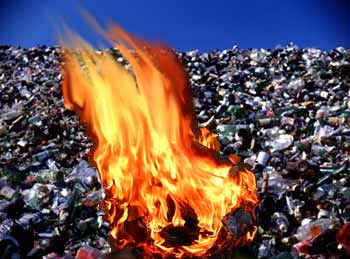 Plastics: Your Formidable Enemy
Plastics: Your Formidable Enemyby Jan Lundberg
Imagine the near future without petroleum, as we try to sustain ourselves and do things in a more natural or austere way. Such as, no plastic hoses replaceable for watering gardens – just when we'll have to do more local gardening for a post-petroleum food supply.
If this were not a serious enough challenge, it turns out that plastics are full of poisons that kill living things including people. Think of it as a permanent, toxic oil spill. The dangers of plastics have been ignored and suppressed for decades, but the recent news on the extent that plastics are killing sea animals and birds will finally raise the human health issue through the environmental focus.
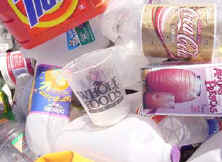 As the danger of the plastics plague may not sink in for years, many people pondering the future today will still mentally cling to their plastic-dependent lifestyles and the perpetuation of the modern industrial economy that relies on myriad forms of petroleum. As we will see in this report, alternative plant-based plastics are not going to do the trick for the world economy. Recycling plastics, as we also learn, is also not very feasible.
As the danger of the plastics plague may not sink in for years, many people pondering the future today will still mentally cling to their plastic-dependent lifestyles and the perpetuation of the modern industrial economy that relies on myriad forms of petroleum. As we will see in this report, alternative plant-based plastics are not going to do the trick for the world economy. Recycling plastics, as we also learn, is also not very feasible.
 "About 250 billion pounds of raw plastic pellets are produced annually worldwide and turned into a tremendous variety of products, from cars and computers to packaging and pens." (Wired News, June 5, 2004). People think of oil mainly as the strategic fuel for their cars, and some Americans justify a foreign policy that kills for oil. If they knew how dependent they were on massive amounts of plastic from oil and natural gas for other basic modern products, the war cry could be louder. However, health-worries during the rising cancer epidemic could counter the demand for endless plastic.
"About 250 billion pounds of raw plastic pellets are produced annually worldwide and turned into a tremendous variety of products, from cars and computers to packaging and pens." (Wired News, June 5, 2004). People think of oil mainly as the strategic fuel for their cars, and some Americans justify a foreign policy that kills for oil. If they knew how dependent they were on massive amounts of plastic from oil and natural gas for other basic modern products, the war cry could be louder. However, health-worries during the rising cancer epidemic could counter the demand for endless plastic.
Plastics, cheap energy, clean drinking water and almost all other key resources are about to become sharply limited. This limitation, brought about by the world's growing population rapidly depleting resources, is a defining aspect of our civilization running up against an immovable wall.
This report draws upon this writer's personal knowledge from his days working for the petroleum industry and then as a defender of the Earth. I've been fortunate to meet leaders such as Captain Charles Moore, who more than anyone worldwide has broken the story on the tragic pollution of the seas caused by plastics. A major news report on plastics as an environmental hazard (from Scripps Howard newspaper service, July 20), was a groundbreaker. By itself it did not put the "plague of plastics" into daily public discourse; we have a long way to go. However, that article said absolutely nothing about the serious effect on public health from plastics. There is plenty of evidence.
 When the full impact of plastics dawns on vocal mainstream people, it could become bigger than the concern over Genetically Modified Organisms currently being slipped into our food and unleashed into nature. People don't realize the biotech industry works hand-in-glove with the petroleum industry. For example, Monsanto is a petrochemical company. They want to control seeds so that farmers will have to buy their herbicides; a pesticide-resistant GMO-crop can have its field get dowsed with profitable poisons that will kill all other organisms such as "weeds." (New York Times, my letter to the editor of Feb. 13, 2002, "Raising Pure Food"). Food, plastics, petroleum and biotech are intertwined and need to be examined in a new light.
When the full impact of plastics dawns on vocal mainstream people, it could become bigger than the concern over Genetically Modified Organisms currently being slipped into our food and unleashed into nature. People don't realize the biotech industry works hand-in-glove with the petroleum industry. For example, Monsanto is a petrochemical company. They want to control seeds so that farmers will have to buy their herbicides; a pesticide-resistant GMO-crop can have its field get dowsed with profitable poisons that will kill all other organisms such as "weeds." (New York Times, my letter to the editor of Feb. 13, 2002, "Raising Pure Food"). Food, plastics, petroleum and biotech are intertwined and need to be examined in a new light.
 Other links
Other links
War on Plastics by Jan Lundberg
Plastics Additives by Jan Lundberg
www.ourstolenfuture.org
Plastic Oceans news article from Wired News, and more.
Algalita Marine Research Foundation, maker of the movie, "Our Synthetic Sea" available for purchase.
Earth Resource Foundation's "Sea Turtles Don't Shop" anti-plastic bag campaign.
Paul Goettlich's Get Plastic Out of Your Diet
and his
PVC: A Health Hazard From Production through Disposal
Scientific American article on "green plastics"
Sustainable business: reuseablebags.com
Scripps Howard plastics article in Seattle daily newspaper.
"Paper or plastic?" Why the kill-for-oil culture will collapse and 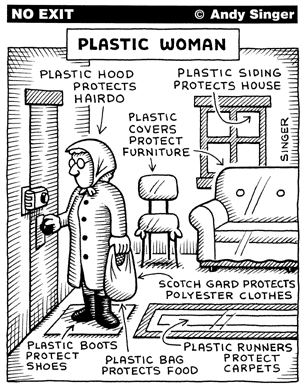 die.
die.
Trash society, trash fashion, trash worship.
"Plastic disaster is creeping on me..." - the Depavers song Green is the Shelter
Funding link below for CAPP:
Donate to the Campaign Against the Plastics Plague (tax deductible; sponsored by the Earth Resource Foundation) to help us help you and the countless creatures harmed by petroleum/plastics. Thank you.
To support Culture Change/Sustainable Energy Institute and its projects, make a tax-deductible donation.


Local Future: Paths to Sustainability
Conference on Michigan's Future -
Nov. 14-16, 2008 Crystal Mountain Resort, Thompsonville, MI
"The Conference of Michigan's Future: Energy, Economy & Environment"
looks at the challenges of the monetary crisis and the oil crisis and proposes realistic, job creating solutions for Michigan.Over two-dozen speakers are confirmed
including Richard Heinberg, Albert Bates, Ellen Brown, Paul Murray, Tony Earley, and Jerry Norica.If you care about Michigan's future, take a moment to visit the Michigan Conference web site and consider participating to help create a brand new vision for Future Michigan.
Conference on
Peak Oil & Climate Change - Online
Local Future hosts the
International Conference on Peak Oil and Climate Change: Paths to
Sustainability.The inaugural conference features 50 presenters including Richard Heinberg, Julian Darley, Dr. David Goodstein, Megan Quinn Bachman, Stephanie Mills, and Pat Murphy.
NEW! - Watch conference presentations & download podcasts for free.
Introduction to Local Future
Unemployment, inflation, war, peak oil, climate change, biodiversity loss, overpopulation -- global problems that need local solutions.
Local Future helps communities develop compassionate, sustainable, local, systems to provide jobs, food, energy, transportation, and essential services.
Local Future Network members develop these systems by helping their
community to transition from dependent units of the failed global economy; to independent cultures of compassionate, sustainable, local economy.
Global Problems
The global economic system creates problems which threaten humanity and the planet:
- peak oil
- climate change
- over population
- resource depletion
- widespread pollution
- misallocation of power
- institutional cruelty
- economic instability
- environmental destruction
- geopolitical conflict & war
This unsustainable global economic system fails to protect humans, the environment, and the natural systems on which all life depends. It does not meet the long term goals of civilization.
When a system fails to such a catastrophic degree, it is time for change.
Local Solutions
New local systems must be developed that are grounded in a value system of truth, compassion, understanding, sustainability, renewal and community. Developing new systems takes dedicated individuals who share the common value system,
walk a common path, and move towards a common vision of the future.
Local systems are needed to provide:
- jobs - that are challenging, safe and community oriented
- money - community currency that creates jobs, motivates
progress and reinforces values- food - that is nutritious, compassionate, sustainable, organic
and available year-round- energy - heat, electricity and fuels from renewable sun, wind, water and biomass sources
- transportation - utilizing ride sharing, mass transit, community vehicles and human power
- homes - safe, comfortable and welcoming, zero energy new homes and retrofits
- water - fresh, clean, free water that is owned and managed locally
- waste management - emphasizing reduce, reuse and recycling
- health care - high quality, low cost, community based services and prevention
- education - local teachers dedicated to providing continuing service
- security - utilizing open communication, problem solving, education and dialogue
- entertainment - opportunities for all to participate and enjoy
- culture - celebrating diversity and history
- spirituality - inviting all people to explore the deeper questions of life
Members of Local Future Network communicate and meet to learn, support, plan, and act. They take the initiative to increase independence for themselves and their communities. Their shared value system of truth, compassion, understanding, sustainability, renewal and community guides their actions toward a vision of a prosperous local future.
Join Local Future
You are invited to make the future a better place.
Join the Local Future Network.
The Conference on Michigan's Future
Energy, Economy & Environment
Crystal Mountain Resort,
Thompsonville, MI
Friday, Nov. 14 - Sunday, Nov. 16, 2008
Local Future Videos
Lights, Camera, Action for Sustainability
Local Future published the following
videos for educational use. These videos, when combined with recommended
resources, provide an excellent start on learning how and why we will be living
a local future.
Peak Oil: The Energy Crisis of Oil Supply Depletion
Aaron Wissner, 10 min
Supply, Demand and Price: The Economics 101 of Peak Oil
Aaron Wissner,
1 min
Conference Welcome and the Greening of Grand Rapids Michigan
George Heartwell, 10 min
Peak Oil and Energy Explained by Dr. Vernon Ehlers, U.S. Representative
Vernon Ehlers, 14 min
Peak Oil (and Gas Prices) in Five Slides
Aaron Wissner, 3 min
What Does it Take to be Sustainable? Some Examples
Aaron Wissner, 9 min
Beyond Sustainability: Surviving Peak Oil and Climate Change
Pat Murphy, 38 min
Surviving Peak Oil, Thriving in Community
Megan Quinn Bachman, 33 min
Peak Oil: How do we know? Is recession coming? What about
insurance?
Aaron Wissner, 3 min
Crude Awakening: Peak Oil and the End of Cheap Energy: Part 1
Tim Hudson, 1 hour
Crude Awakening: Peak Oil and the End of Cheap Energy: Part 2
John Richter, 1 hour
Re-Energizing America: Rescuing America from its Costly Fossil Fuel Addiction
Dan Chiras, 1 hour
Curtailment & Community: Survival Strategies for Peak Oil & Climate Change
Megan Quinn Bachman, 20 min
Interview with Megan Quinn Bachman on Peak Oil and Community Solutions
Megan Quinn Bachman, 15 min
 In recent elections, electronic voting machines have:
In recent elections, electronic voting machines have: The use of electronic voting machines increases:
The use of electronic voting machines increases: Certainly the outlook for democracy seems pretty bleak-and how could it be otherwise? The surest way to make a problem worse is to pretend it isn't there, which is exactly what our press and politicians have been doing; and the rest is, unfortunately, history.
Certainly the outlook for democracy seems pretty bleak-and how could it be otherwise? The surest way to make a problem worse is to pretend it isn't there, which is exactly what our press and politicians have been doing; and the rest is, unfortunately, history.
But history can be changed, as We the People have continually learned, from our refusal of colonial subjection, to our (partial) establishment as a democratic republic, to the abolition of slavery, to the enfranchisement of women, to the end of formal segregation and the passage of the Voting Rights Act.
After that, our progress seemed to stop, and it must now resume: for history can be changed, and for the better, but only through our own unbreakable commitment to, and action for, enlightened policies for the renewal of our democracy. Based squarely on America's first principles, such policies would not be wholly new, however revolutionary they must sound in these bad, backward times. As it was certain policies that got us into this horrific situation, certain other policies can get us out.
The fact is that We the People are in lousy shape, and must get straight as soon as possible. For we are all addicted to the horse race-and we can't win, because it's fixed. And so, before we end up losing everything, we need to pull ourselves together, face the music, and then take all necessary steps to change the tune.
A 12-Step Program to Save US Democracy
 1. Repeal the Help America Vote Act (HAVA).
1. Repeal the Help America Vote Act (HAVA).
This step will inevitably follow an in-depth investigation of how HAVA came to be.

 2. Replace all electronic voting with hand-counted paper ballots (HCPB).
2. Replace all electronic voting with hand-counted paper ballots (HCPB).
Although politicians and the press dismiss this idea as utopian, the people would support it just as overwhelmingly as national health care, strong environmental measures, US withdrawal from Iraq, and other sane ideas.
3. Get rid of computerized voter rolls.
It isn't just the e-voting machines that are obstructing our self-government. According to USA Today, thousands of Americans have had their names mysteriously purged from the electronic databases now used nationwide as records of our registration.
 4. Keep all private vendors out of our elections.
4. Keep all private vendors out of our elections.
With their commercial interests, trade secrets and unaccountable proceedings, private companies should have no role in the essential process of republican self-government.
 5. Make it illegal for the TV networks to declare who won before the vote-count is complete.
5. Make it illegal for the TV networks to declare who won before the vote-count is complete.
Certainly the corporate press will scream about its First Amendment Rights, but they don't have the right to interfere with our elections. When they declare a winner BEFORE WE even know if the election was legitimate, they PRE-DEFINE all audits, recounts and even first counts of the vote as the mere desperate measures of "sore losers."
6. Set up an exit polling system, publicly supported, to keep the vote-counts honest.
Only in America are exit poll results not meant to help us gauge the accuracy of the official count. Here they are meant only to allow the media to make its calls.
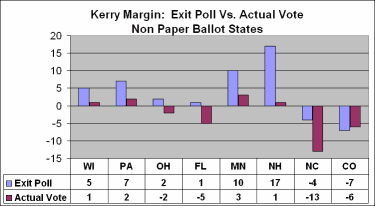 7. Get rid of voter registration rules, by allowing every citizen to register, at any post office, on his/her 18th birthday.
7. Get rid of voter registration rules, by allowing every citizen to register, at any post office, on his/her 18th birthday.
Either we believe in universal suffrage or we don't.
8. Ban all state requirements for state-issued ID's at the polls.
As the Supreme Court smiles on such Jim Crow devices, we need a law, or Constitutional amendment, to forbid them.
9. Put all polling places under video surveillance, to spot voter fraud, monitor election personnel, and track the turnout.
We're under surveillance everywhere else, so why not?
 10. Have Election Day declared a federal holiday, requiring all employers to allow their workers time to vote.
10. Have Election Day declared a federal holiday, requiring all employers to allow their workers time to vote.
No citizens of the United States should ever lose the right to vote because they have to go to work.
 11. Make it illegal for Secretaries of State to co-chair political campaigns (or otherwise assist or favor them).
11. Make it illegal for Secretaries of State to co-chair political campaigns (or otherwise assist or favor them).
Katherine Harris wore both those hats in Florida in 2000, and, four years later, so did Ken Blackwell in Ohio and Jan Brewer in Arizona. Such Republicans should not have been allowed to do it, nor should any Democrats.
 12. Make election fraud a major felony, with life imprisonment--and disenfranchisement--for all repeat offenders.
12. Make election fraud a major felony, with life imprisonment--and disenfranchisement--for all repeat offenders.
![]() "Three strikes and you're out" would certainly befit so serious a crime against democracy.
"Three strikes and you're out" would certainly befit so serious a crime against democracy.
***
This comes from Loser Take All: Election Fraud and the Subversion of Democracy, 2000-2008, a new collection of writings by the major Election Integrity people, which IG Publishing will be bringing out in early April.
"Heading into another presidential race, We the People have to face the fact that our election system is a shambles, run by private corporations with a partisan agenda, and largely based on a technology that anyone can rig. This great book will tell you all about it—and, even more important, help us overcome it.”—Thom Hartmann
"Before Americans get too excited about the next election, they'd do well to remember the stolen elections of 2000 and thereafter. For all the talk of “change,” the corrupt system by which we vote remains broken. Thank heavens for Mark Crispin Miller and his contributors who call not just for awareness, but action”—Laura Flanders
“The essays in this great collection make it clear that our democracy is in trouble. We can begin to repair our nation by restoring electoral integrity. This book points to the challenges and the possibilities of regaining our full power as voters and citizens in a democratic society.”—Dennis Kucinich
“Loser Take All presents cutting edge essays that diagnose a problem still ignored by much of the political establishment and the news media. The book provides a roadmap to a truly open and fair voting system.”—Robert W. McChesney
Loser Taker All: Election Fraud and The Subversion of Democracy, 2000-2008 is an indispensable anthology of writings covering the vast election fraud that has been perpetrated by the GOP—with the Democratic Party’s acquiescence—since 2000. Among the subjects treated here are: the myth of George Bush’s victory in Florida in 2000, and FOX News’s key role in propagating it; Senator Max Cleland’s dubious defeat in Georgia in 2002; Bush’s “re-election” in 2004, including evidence of systematic fraud outside of Ohio; startling evidence of fraud committed in the 2006 midterm elections, which the Democrats appear to have won by a far larger margin than officially reported; and, crucially, evidence that the Republicans will attempt to steal the presidential election in 2008.
Edited by Mark Crispin Miller, author of the seminal Fooled Again: The Real Case for Electoral Reform, this explosive collection includes works by a broad range of well-respected election activists, including Robert F. Kennedy Jr., David Moore, Bob Fitrakis, Larissa Alexandrova, Michael Collins, Lance deHaven-Smith, Brad Friedman, David Griscom, James Gundlach, Jean Kaczmarek, Paul Lehto, Bruce O'Dell, Michael Richardson, Steven Rosenfeld, Jonathan Simon and Nancy Tobi.
Some images from: http://www.hermes-press.com/vote_rig.htm